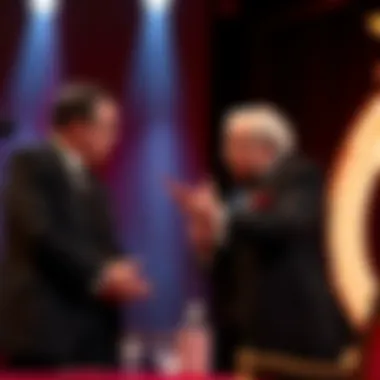The Art of Deception: Penn and Teller's Legacy in Vegas


Intro
The magic realm of Penn and Teller is a tale spun from threads of illusion, psychological manipulation, and profound audience engagement. In the neon-drenched ambiance of Las Vegas, where every corner teems with chance and spectacle, this iconic duo has carved a niche that transcends mere performance. They aren’t just entertainers; they’re narrators in a dazzling story about trust and deception. Through their unique brand of magic, they invite spectators to see beyond the smoke and mirrors, exploring the fine line between what is real and what is illusion.
Las Vegas, a city synonymous with risk and reward, finds its perfect match in Penn and Teller's performances. Their philosophy dives deep into the nature of magic itself while simultaneously tackling broader themes of gambling and ethical conduct. By merging elements of comedy with their trickery, they’ve not only entertained, but also educated audiences about the nuances of deception. As we unfold this narrative, we shall explore how they’ve influenced the local entertainment landscape and, by extension, the gambling community.
In both their performances and their outspokenness about responsible gambling, they reignite conversations on addiction and the moral responsibilities of entertainers. The essence of Penn and Teller’s appeal lies in their ability to create a safe space where audiences are encouraged to question what they see, fostering a unique blend of wonder and skepticism.
As we delve into this art form, it'll be crucial to recognize the multi-faceted approach they take toward illusion, audience interaction, and the ethical implications tied to gambling. This exploration not only highlights their career but also the evolving landscape of entertainment in Las Vegas.
Preamble to Penn and Teller
The world of magic is filled with illusions, smoke, and mirrors, but few capture the essence of this art form quite like Penn and Teller. This iconic duo has been a cornerstone of the Las Vegas entertainment scene, blending elements of traditional magic with a unique brand of humor and audience engagement. Their performances not only entertain but also challenge the very fabric of how we perceive magic and deception.
Understanding the significance of Penn and Teller is paramount, especially for gamblers and casino enthusiasts. Their approach to magic isn’t just about the trick; it’s about building trust with the audience while simultaneously breaking it down. They expose the mechanics of some illusions, a move that may seem counterintuitive in the world of magic, yet it strengthens the audience's connection and engagement.
Integral to their appeal is the raw honesty that Penn and Teller embody. They present themselves as not merely tricksters but as individuals who engage in a dialogue about deception in both magic and gambling. Their performances serve as a reflection on the themes of risk, reward, and trust—elements that resonate deeply with any gambler. Knowing their background, their approach, and the philosophies they weave into their magic lays the groundwork for fully appreciating their contributions to the art form.
In this section, we will dive deeper into their early lives, exploring how their unique backgrounds shaped their artistic paths. Following that, we will examine how their individual talents merged to create an iconic partnership that has enthralled audiences around the globe.
The Las Vegas Stage
The stage of Las Vegas is more than just a physical location; it represents an intricate canvas where performers craft their narratives, and in that realm, few shine as brightly as Penn and Teller. The Las Vegas stage is synonymous with grand spectacles and memorable performances, making it the ideal backdrop for artists who thrive on theatricality and audience engagement. It serves as not only a venue but a cultural touchstone in the world of illusion and entertainment.
In this vibrant atmosphere, Penn and Teller have carved their legacy, offering audiences a blend of humor and magic that elevates the craft to new heights. Their approach to performance benefits from the unique energy of this city that rarely sleeps. The swift pace and constant excitement of Las Vegas create an environment where innovative acts flourish, encouraging artists to push boundaries.
History of Performance in Vegas
Las Vegas has long been known as the playground of America, a place where performers come to dazzle and astound. The history of performance in this desert city reflects a transformation from small cabaret shows to grand productions in luxurious resorts. Back in the day, Elvis Presley set the stage for a flamboyant era, making it common to witness larger-than-life shows.
As the city evolved, so did its forms of entertainment. Magicians gained prominence throughout the decades, with iconic names like Siegfried & Roy showing how illusions could captivate audiences in elaborate, theatrical ways. The introduction of modern casinos brought lavish spectacles into the fold, merging gambling with stunning performances.
Penn and Teller arrived in Las Vegas during a time when unique acts rising above the noise were desperately needed. They seized the opportunity by presenting a fresh take on magic that stood out from the more traditional performances. Incorporating wit and self-deprecation, their shows became a remarkable reflection of the rapidly evolving Las Vegas landscape, intertwining their craft with the city's energetic history.
Setting Their Roots
Getting their start in Las Vegas during the 1980s, Penn and Teller began to set their roots deeper than just the glitzy façade of the Strip. They embraced the city’s ethos of reinvention, regularly updating their acts to keep pace with changing tastes and audiences. Their early shows saw them perform in smaller venues before the duo understood the possibilities of larger stages. With grit and determination, they polished their blend of comedy and magic, catching the eye of many.
They quickly found a loyal fanbase enticed by this distinctive approach to magic. Unlike typical magicians, who might hide behind a veil of mystery, Penn and Teller made their process part of the show. By revealing some of the secrets behind their illusions, they built a relationship of trust with their audience, an approach that resonated in this city of vice and wonder.
Setting roots in Las Vegas helped solidify their identity and performance style. With the consistent crowd of eager tourists and locals alike, their shows became showcases not just of magic, but of the fundamental ideas of trust and betrayal, woven deeply into the narrative fabric of Las Vegas. Overall, the Las Vegas stage became a fitting testament to their proverbial dance between illusion and reality.
Unique Elements of Their Performance
The magic performance of Penn and Teller is far from your run-of-the-mill spectacle; it's a carefully crafted blend of art, intellect, and sheer entertainment. Their approach to magic defies traditional norms, engaging audiences on multiple levels. This section delves into the unique elements that define their act, illuminating why they stand out in the crowded Las Vegas entertainment landscape.
Blend of Comedy and Magic
A key element of Penn and Teller's allure is their seamless pairing of comedy with magic. This blend doesn't merely serve as a distraction from the tricks; it enhances the overall experience. The duo has cultivated a distinctive comedic style that provokes laughter while simultaneously heightening the mystery of their illusions.
For instance, Penn Jillette's iconic spoken word is laced with humor, creating dialogue that resonates with spectators. Teller, who traditionally remains silent, employs physical comedy, his expressions adding layers to the performance. This interplay between them creates a rhythm; as one delivers a punchline, the other pulls off a trick, maintaining audience engagement and elevating anticipation.
Moreover, this comedic edge makes magic more accessible. By breaking down the walls of convention, they invite spectators to laugh at themselves as they ponder how the illusions are crafted. It's a dance of intellect and jest, prompting you to question not just the hows and whys of magic, but also your own expectations. Ultimately, it underscores a critical theme: in trusting the magician, there’s also room for joy and laughter.
Breaking Traditional Illusion Norms
Breaking norms is practically a hallmark of Penn and Teller's performances. Traditional magic often thrives on secrecy, concealing how tricks are executed. In contrast, this duo adopts a refreshing approach by demystifying the mechanisms behind some of their illusions right on stage. They expose the illusion, yet simultaneously maintain a sense of wonder.


For example, in their famous “Bullet Catch,” they not only perform the illusion but also offer insight into the mechanics. This candidness is not merely a gimmick; it serves as a thought-provoking commentary on trust. As Penn explains the logistics, it challenges the audience’s perception of magic while instilling a deeper appreciation for their skill. In a world where deception is oftentimes perceived as malicious, they redefine it as an art form that can invite admiration rather than suspicion.
This subversion of tradition positions Penn and Teller as not just performers, but philosophers of magic. By blurring lines between reality and illusion, they evoke questions about belief, skepticism, and the very nature of truth.
Audience Participation and Trust
One cannot discuss the unique aspects of Penn and Teller’s performances without mentioning their dynamic relationship with the audience. Trust is a pivotal element in their acts. They frequently invite audience members on stage, thereby fostering a sense of community. This interactive layer adds depth to their performance, allowing spectators to feel part of the spectacle.
Their ability to engage with audiences goes beyond mere participation—it explores the intricacies of trust in the context of gambling and magic. They rely on the audience's willingness to suspend disbelief, paralleling the essence of a gamble. When someone stands up to be involved in a trick, they’re placing their trust entirely in Penn and Teller’s hands. It can be likened to poker players laying down their cards, serving as a reminder that the act of deception is not merely a byproduct of magic but a fundamental human experience.
In these moments, you witness more than magic; you observe the act of building a bond based on shared experience. Trust, therefore, becomes the bedrock upon which their illusions stand. This interactive facet is not just a trick up their sleeves— it’s where the art of deception truly blossoms.
In summary, both the comedic elements and the breaking of norms cement Penn and Teller’s unique performance style, while their engagement with the audience exposes deeper themes of trust. In a world consumed by skepticism, their ability to merge these aspects into a cohesive act speaks volumes about their mastery of the craft and cements their legacy in the annals of magic.
Exploration of Their Illusions
Diving into the realm of illusions crafted by Penn and Teller, one can’t help but realize the significant role that this aspect plays within the broader canvas of their performances. The acts they present are more than mere parlor tricks; they're profound explorations, revealing insights into human psychology, trust, and the very nature of reality. They skillfully blend humor with the art of deception, pushing boundaries while provoking thought. This section will discuss their signature tricks and how the mechanics behind their illusions elevate their art form.
Signature Tricks and Creations
Penn and Teller have developed a repertoire of signature tricks that resonate deeply, each with its uniqueness. Take, for instance, "The Bullet Catch," which, despite being a classic act, is executed with a twist that leaves audiences both awestruck and squirming in their seats. The reveal isn’t just a mere surprise; it challenges the very trust established between the performers and their audience. In the context of modern magic, these performances serve as benchmarks for aspiring magicians.
Some additional notable tricks include:
- Fire Eating: This trick, while simple on the surface, embodies the principle of audience trust. One has to wonder, how can they so confidently play with fire?
- The Three Card Monte: Adapted in their unique style, this classic deception not only entertains but also serves as a metaphor for the nature of trust in gambling and life itself.
- The Invisible Deck: This creation not only dazzles but also leaves spectators questioning the very fabric of their decision-making in the context of magic.
The importance of these tricks transcends mere entertainment value; they challenge audiences to confront their beliefs about perception and reality.
The Mechanics of Deception
Understanding how Penn and Teller pull off their illusions paves the way to appreciate the art form on a deeper level. This isn't just about sleight of hand; there’s a rich tapestry of psychological manipulation at play. By meticulously crafting narratives and employing a range of techniques such as misdirection and timing, they build a scenario that compels the audience to engage on multiple levels.
For instance, their reliance on surprise endings creates a cognitive dissonance that keeps audiences guessing. They often demonstrate that what seems impossible can, in fact, be possible — if only for a fleeting moment.
Aspects worth noting include:
- Misdirection: This is a crucial part of any magician's arsenal. Penn and Teller elevate this by incorporating humor and storytelling, which allows them to distract while delivering the unexpected.
- Psychological Pacing: The pacing of jokes and trick executions builds anticipation. Audiences are led down a path and then given a sudden jolt that leaves them bewildered, questioning their own perceptions.
- Simplicity in Complexity: The tricks, while intricate, often rely on simple principles — an element of genius that creates a layered experience for the spectator.
"The easiest way to confound people is to give them exactly what they expect — and then twist it on its head."
This witty observation speaks volumes about how Penn and Teller use strategic planning to craft their illusions. Their work fundamentally underscores that magic is not merely an act of trickery; it’s an exploration of human nature and an inquiry into the fabric of reality.
To conclude, the exploration of their illusions reveals that the allure of Penn and Teller lies not just in surprising feats but in how they challenge us to question the world around us. Through their artistry, they call into question the very essence of trust, inviting spectators to engage with the deeper themes of reality and deception.
Thematic Elements in Their Work
The thematic elements present in the performances of Penn and Teller are what set them apart in the realm of magic. Their work goes beyond mere tricks; it invites the audience to engage in a complex narrative surrounding trust and deceit. In dissecting these themes, one can see how they resonate with both the layman and the seasoned gambling enthusiast.
Exploring Trust and Deceit in Magic
Trust is a pivotal aspect of magic, particularly for Penn and Teller. They often delve into the very heart of deception, creating a platform where illusions thrive on the foundation of trust. Their performances start with an unwritten agreement: the audience chooses to believe that what they are witnessing is real, even when they know it's not. This paradox is central to understanding their artistry. They brilliantly illustrate how humans are wired to trust, despite the conflicting cues that signal otherwise.
For instance, during their routine "The Bullet Catch," the trust involved is palpable. The audience knows the trick hinges on deception and yet feels compelled to suspend disbelief. It's a precarious dance, and Penn and Teller navigate it with stunning skill, emphasizing the relationship between the performer and the audience. This dynamic offers a rich ground for reflection—how often in life do we place trust in situations that, at a glance, might appear fraught with danger?
Moreover, the duo does not shy away from making the audience a part of this exploration. They often invite viewers into the narrative, encouraging them to confront their biases and assumptions about what they see. This interaction fosters a unique bond, transcending the typical magician-audience divide. The realization that we are all susceptible to deception becomes a disarming point of connection, challenging audiences to reckon with their own tendencies toward trust.
Philosophical Implications of Illusion
The philosophical undertones in Penn and Teller's work are as profound as they are engaging. Illusions force us to confront the nature of reality, perception, and the senses. At its core, magic serves as a conduit for philosophical inquiry, and the duo has mastered this art.
They navigate concepts such as what constitutes truth in an age where information is often manipulated. In their iconic performance, "The Vanishing Elephant," Penn and Teller play with the idea of disappearance as a metaphor for the transient nature of truth itself. As the audience watches the elephant seemingly vanish, it prompts deeper questions about existence, awareness, and the fleeting moments that make up our reality.


In a way, they are philosophers in capes. Their performances challenge viewers to examine the world critically. Why do we believe what we see? How much of our perception is shaped by external influences and past experiences?
To quote Penn, "The truth is not always what it seems." This encapsulates the essence of their work: a blend of illusion, introspection, and the ongoing human quest for understanding. The implications extend far beyond the theater; they invite contemplation on the nature of truth in everyday life.
By cleverly intertwining these philosophical notions within their acts, Penn and Teller not only entertain but also enrich the intellectual fabric of their performances. They invite an ongoing dialogue about trust, perception, and reality that resonates deeply with their audience, making their magic a compelling commentary on the human condition.
For further reading about the impact of trust in magic and the psychology behind illusions, visit Psychology Today or delve into studies available on Academia.edu.
"The greatest trick the Devil ever pulled was convincing the world he didn't exist."
- The Usual Suspects
Cultural Impact and Legacy
The cultural impact and legacy of Penn and Teller stretch beyond just the glitzy lights of Las Vegas. Their influence permeates the broader world of entertainment and the very fabric of modern magic. This section aims to explore how their performances have shaped perceptions of magic, the role of deception, and the essential themes of trust that resonate through their work.
Influence on Modern Magic
Penn and Teller have undoubtedly left an impressively sizeable mark on modern magic. Their unique blend of humor and illusion acts has encouraged magicians worldwide to rethink traditional approaches. Unlike many in the magic community, who often focus solely on mystique and misdirection, Penn and Teller embrace the idea of demystifying magic. They present themselves more as entertainers than mere illusionists, inviting their audience to appreciate the craft behind the curtain.
Their famous routine, "The Bullet Catch," serves as a prime example. By revealing the mechanics without diminishing the thrill, they invite spectators to ponder not just how the magic happens but why it captivates us in the first place. In doing so, they've inspired countless performers to incorporate storytelling into their techniques, elevating magic from simple tricks to narratively-rich experiences that engage audiences on a deeper level.
Additionally, they have brought magic into mainstream media through their various shows and television specials. This exposure has been invaluable in reshaping the perception of magic as not just a separate niche but as a major form of entertainment, akin to concert performances or Broadway shows.
Recognitions and Awards
Penn and Teller's innovative approach has not gone unnoticed; they have garnered numerous accolades over the years that speak volumes about their craft and dedication to the art of illusion. Their contribution to magic has resulted in various awards that highlight their skill, creativity, and influence.
- Magician of the Year: Awarded by the Academy of Magical Arts, emphasizing their significant contributions to the magic community.
- Lifetime Achievement Award: This prestigious recognition celebrates their lasting impact on the art of magic.
- Emmy Awards: For their groundbreaking television specials that not only showcased magic but also included social commentary and real-life issues.
- Hollywood Walk of Fame Star: Recognizing their influence on pop culture as entertainers who have transcended the realm of magic.
These honors reflect not just their excellence in performance, but also their willingness to challenge norms. Their commitment to ethical principles, including promoting responsible gambling, shows that they leverage their platform for greater societal good. The fact that they are known not just for their acts but their advocacy emphasizes their legacy beyond just tricks.
"Magic is not just about what you see, but it's about creating a connection with your audience through trust and story."
Connection to the Gambling World
Magic and gambling share a fascinating intersection, especially in a glitzy locale like Las Vegas. In the realm of chance, both spheres play on themes of uncertainty, risk, and the element of surprise. This dynamic connection enhances the artistry of Penn and Teller’s performances, where they expertly navigate the realms of deception that are so prevalent in both magic and gambling.
From the thrilling rush of betting to the mind-bending tricks devised by this iconic duo, the gambling world provides a rich tapestry from which they draw inspiration and narrative. For enthusiasts of both magic and gaming, this article delves deeper into how their art marries the thrill of risk with the subtleties of illusion learn more about in the segments below.
Responsible Gambling Promotion
Penn and Teller's approach goes beyond mere entertainment, as they actively promote responsible gambling—a crucial aspect of their performances. Their ethos touches upon the well-being of the audience, providing insights into the psychology behind gambling while advocating for moderation and awareness. Their innovative show often lightly jokes about the perils of unchecked gambling habits, yet the underlying message remains serious and profound. Through this lens, they strive to ensure that gambling remains a fun pastime instead of a harmful addiction.
"Gambling should be a source of joy, not despair," quotes Penn Jillette, emphasizing the importance of a balanced perspective.
In their performances, viewers get a glimpse into the darker side of luck and chance—a world where deception can lead one astray, mirroring the unpredictability of gambling outcomes. Thus, the deck used on stage serves not only as a tool for magic but as a metaphor for the risks that wagerers face. Their clarity on this topic cultivates a responsible dialogue about gambling that resonates with seasoned players and novices alike.
Psychology of Risk and Reward
At the heart of gambling lies a dance with risk and reward; this is where Penn and Teller excel as entertainers. Their mastery of psychological nuances proves pivotal in crafting both illusions and experiences that echo the exhilarating highs and harsh lows of gambling. The duo uses psychological principles in their act to engage the audience's imagination and emotions, tapping into innate human desires for thrill.
Understanding the psychological triggers that maximize engagement is pivotal in their performances. They create scenarios that draw spectators in, mirroring the allure of a slot machine or the anticipation of rolling dice. Here are some aspects they focus on:
- Anticipation: Just like in a game of poker, the build-up is integral. The unveiling of a trick is akin to awaiting a high-stakes hand.
- Uncertainty: Their illusions maintain an element of surprise, simulating the unpredictability often encountered in gambling.
- Social Dynamics: Interactions within the audience reflect the camaraderie and competition found on the casino floor, enhancing the performance's relatability.
In essence, Penn and Teller’s performances are a study in the psychology of allure, much like the gamble that entices players. By intertwining these elements, they not only entertain but also foster an understanding of the dynamics at play in both magic and gambling, urging audiences to contemplate their relationship with risk and reward.


To further explore the psychology of gambling and performance, consider visiting resources like National Council on Problem Gambling or Gamblers Anonymous.
Their Broader Influence in Entertainment
The realm of entertainment is plush with innovation, and few have wielded influence quite like Penn and Teller. Their ability to blend magic with various art forms has reshaped perceptions and expectations in the saturated scene of Las Vegas. By marrying illusion with narrative and humor, they're not merely performers but cultural commentators who provoke thought while entertaining.
In examining their broader influence, one notices their insights into human psychology, particularly regarding trust, belief, and the underlying mechanics of deception. Every show they present has more depth beyond the tricks, allowing audiences to reconsider their relationships with reality and entertainment.
Impact on Television and Media
Penn and Teller's imprint on television is unmissable. Their series, Penn & Teller: Bullshit!, tackled controversial topics with a mix of skepticism and humor. They dissected everything from paranormal claims to conspiracy theories, pushing audiences to question rather than just accept. This approach helped to redefine the documentary landscape, where humor and magic sparked intrigue and inquiry.
Their television ventures are not mere performances; they synthesize entertainment and advocacy. Through their platform, they elevate discourse on topics often swept aside or misrepresented. Consequently, many viewers have been inspired to delve deeper into subjects they might have previously dismissed.
Moreover, their magical talent found new life through appearances on numerous talk shows and reality series, keeping magic relevant in the contemporary media landscape. Penn and Teller’s skillful art of deception has led to magic becoming increasingly mainstream, resonating both with traditional enthusiasts and a new generation eager to engage with this art form.
Collaboration with Other Artists
Collaboration is another cornerstone of Penn and Teller's contribution to entertainment. They have worked with a variety of artists and performers across disciplines, blending their brand of magic with music, theater, and even street art. Such partnerships breathe new life into their performances and expand the boundaries of traditional magic.
For instance, their collaboration with musicians creates an immersive experience, where the illusion becomes a part of a larger artistic expression. Likewise, their engagements with other magicians foster an environment of shared creativity, encouraging the next generation. Through these alliances, not only do they push their own boundaries, but they help elevate the entire field of magic, propelling it forward into uncharted territory.
In this light, Penn and Teller seem to believe that art thrives on dialogues. They showcase that the act of creating is a collective endeavor, challenging others in the industry to collaborate and innovate in a similar manner. Therefore, their influence stretches far beyond the spotlight—richening cultural narratives and encouraging a cooperative spirit amongst diverse artists.
The Future of Penn and Teller
The intriguing journey of Penn and Teller, a duo that’s become synonymous with magic in Las Vegas, raises the question of their trajectory as they continue to evolve. As they forge ahead, their performances reflect a unique blend of tradition and modernity, which speaks volumes about the importance of this topic. Understanding the future of Penn and Teller is crucial not just for their aficionados but also for those who appreciate the art of deception, magic, and the role of entertainment in today's world.
Penn and Teller's signature style, characterized by blending humor with illusion, has permanently etched them into the fabric of the Las Vegas entertainment landscape. As they continue to entertain and captivate audiences, many considerations come into play. The duo's ability to adapt to changing audience expectations while maintaining their core principles will prove vital. Moreover, the sustainability of their brand hinges on how they embrace advancements in technology and audience engagement practices.
Continuing Evolution in Performance Style
As the entertainment industry undergoes transformation, so too has Penn and Teller adapted their performance style. Traditionally, magic was often shrouded in secrecy, but they’ve taken a different approach. With each show, they peel back the curtain on the mechanics of their tricks, placing the audience in on the joke, so to speak. This refreshing take represents a shift from conventional norms, showcasing a blend of transparency and charm.
Their approach has evolved over the years, ensuring that they resonate with a wide range of spectators, from seasoned magicians to first-time viewers. Integration of current events and social commentary into their acts not only keeps their performances relevant but also provides a platform for engaging dialogue with audiences.
Moreover, technical advancements in lighting, sound, and video have found a place in their repertoire, pushing the boundaries of traditional magic shows. The use of innovative stagecraft not only heightens the visual experience but also plays into the illusions they create, harmonizing technology with artistry.
"Magic is not about tricking people; it's about entertainment, and we aim to entertain in ways that resonate now."
Plans and Innovations Ahead
Looking forward, Penn and Teller have a plethora of plans and innovations to keep their performance fresh and captivating. The duo recognizes that simply maintaining the status quo is not an option; rather, they intend to push the envelope continuously. This desire to innovate hinges on several strategies, including collaboration with other artists and performers, embracing new technologies, and expanding their reach beyond traditional venues.
Their commitment to responsible gambling and educating audiences, especially in a city like Las Vegas, speaks to their foresight. Future plans may see them taking social responsibility to new heights by integrating elements of ethical gaming into their acts. Workshops and educational sessions could potentially bridge the gap between entertainment and the principles of responsible gambling, making their brand not just relevant, but also socially impactful.
They also appear to be considering the integration of digital platforms to reach broader audiences. Streaming shows or virtual performances might not only cater to fans who can’t make the trip to Las Vegas but also introduce them to new audiences across the globe. This endeavor can elevate their visibility while maintaining the core of their craft.
In summary, the future of Penn and Teller is not merely an extension of their past endeavors; it is a nuanced exploration of what lies ahead. With an eye on innovation and audience interaction, they uphold a legacy that honors the art of deception while paving new paths in the world of entertainment.
For more insights and further reading, you may explore Wikipedia, or visit Britannica for comprehensive biographies and detailed histories.
Closure
The conclusion serves as a vital anchor for this article, encapsulating the essence of Penn and Teller's profound influence on the realm of magic, entertainment, and even the gambling culture. Their artistry goes beyond mere tricks; it delves deep into the theme of deception, fostering a dialogue about trust, ethics, and the complexities embedded within the world of illusions.
Summarizing their Impact
When evaluating the impact of Penn and Teller, several key aspects emerge. First, their innovative blend of magic and comedy stands out, setting them apart from other performers. This fusion not only entertains but also elevates the audience's understanding of the performance. They invite spectators to question their perceptions and challenge their beliefs about what they see.
Moreover, their commitment to responsible gambling connects to a larger narrative in today's world. They align themselves with the principles of ethical entertainment, encouraging players to engage with gambling in a way that is thoughtful and informed. This approach is vital, especially in a city like Las Vegas, where the allure of gaming can overshadow the importance of understanding one’s limits.
Their legacy extends to how they have reshaped the magic industry, inspiring many upcoming magicians and entertainers. By dismantling the pretenses of traditional magic—transparency and humor slide through to form a new paradigm—Penn and Teller have nudged the boundaries of what is acceptable in live performance.
In a nutshell, the essence of Penn and Teller’s performances is more than just magic tricks or witty banter; it is a rich tapestry woven with threads of philosophy, artistic integrity, and social responsibility. This depth is what captures the fanfare of both amateurs and seasoned audiences alike, ensuring that their impact will resonate for generations to come.







